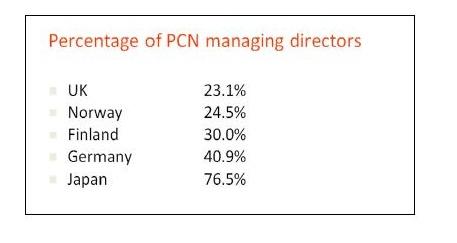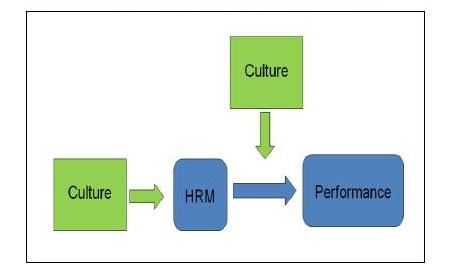How can we explain the country-of-origin effect represented in this table?

Staffing multinational affiliate companies is a critical success factor and a very challenging task. The biggest question for Multinational Companies (MNC) is whether to embrace across border transfers i.e. send parent country nationals (PCN) to manage the affiliates or use locals. This is a critical question especially when considering top managers and directors because they make important decisions and chart organizational growth. It is the top managers that make strategic decisions in the affiliates. Therefore, MNC’s are keen on establishing strategic control on affiliates.
As the table above shows, using PCN as top management directors in affiliates is always dependent on MNC country of origin characteristics. The country of origin characterizes the organizational culture and structure of multi-national companies. The compatibility of organizational culture with host country characteristics determines choice on whether to send in PCN or use local talent. More crucially, this decision is determined by level of trust or level of suspicion of others enshrined in given country of origin cultures.
Trust and suspicion determine how welcome uncertainty is in a culture. Further, the extent of trust in an organization helps towards determining the acceptable power distance levels in cultures. The percentages in the table above show that Japan has the highest PCN top directors in its affiliates followed by Germany, Finlay, Norway then UK. The country of origin effect on percentage of PCN management directors in MNC affiliates can be explained by the power distance and uncertainty acceptance differences in the cultures in those countries.
European culture tends to be a liberal culture characterized by more trust towards others than in-group formation or closing in culturally. It is more accommodative of difference and power is more individual based than collective ascription based. European cultural practices have spread all over the world in what is widely known as ‘western influence’. From the various factors, European MNC’s are more likely to adopt geocentric or polycentric staff deployment mechanisms. Japan and other Asian cultures are closed in i.e. not very open to dialogue with other cultures. Japanese firms tend to be knit family or clan empires that are closely monitored thus tend towards ethnocentric kind of staff deployment. Japans culture tends to command higher levels of trust and loyalty; the power distance is high while uncertainty distance is very low.
Discuss four major forces that affect the direction and intensity of cross-border HR transfer
Cross border executives transfer has become very intense in the recent past because majority of businesses are keen on benefiting from globalization. Globalization basically refers to the new reality characterized by the world being more like a small village. Due to ease in communication and transportation as enabled by technology, people around that world have immediate contact with each other via the internet and other communication media such as teleconferencing.
Secondly, changing socio-economic and political thinking has provided for more integration amongst nations. For instance, the European nations are now integrated as one bloc i.e. the EU with one currency. Economic, political and social integration facilitate cross border transfer of executives as road blocks or barriers to such movements become less or are eliminated completely.
Liberalization of markets, creation of free market economies and efforts towards privatization as opposed to nationalization are also facilitating cross border Executives transfer. For instance, many national corporations especially in the third world countries are being privatized as a survival mechanism. In the face of increased competition from multinationals, only best business practices can guarantee success. As national corporations, incompetence and vested interests makes profitable running of some commercial concerns impossible. As international companies buy into national corporations that are being privatized, cross border executives or HR transfer is necessitated.
Explain the core ideas carried by the figure below.

HRM practices are dependent on cultural setting. The cultural setting refers to organizational culture cultivated and the socio-cultural setting or context within which the organization operates. For multinational companies, culture affects HRM practices at two levels. First there is the home country culture that informs practices in the organization. These practices are often carried over into the host countries. However, the host country has its own cultural peculiarities that have to be embraced. Therefore, the culture in the host country informs the HRM practices in subsidiaries or overseas outlets.
What the diagram demonstrates is that organizational performance is largely dependent on how the human resource and human resource managers interact or respond to cultural both in and beyond the organization. Each organization has its distinct culture. Human resource management practices are dependent on organizational culture as nurtured by management. For multinational organizations, home country practices are often different from host country practices. Therefore, culture has to inform HRM practices as HRM appropriates organizational culture towards establishing a working culture. It is only after cultural differences have been ironed that individuals can optimally perform.
Success of organizations, among other things, is dependent on cultural smartness. Cultural difference affects the way employees handle their respective duties. Consequently, cultural flexibility is an important factor to consider when hiring employees. Any employee joining the organization comes with a cultural baggage and meets the culture of the organization. HRM practices have to act as a buffer between the two cultures i.e. culture from which employee hails and culture in which the employee is to work. By so doing, cultural differences only enrich the working culture in the organization as opposed to becoming an impediment.